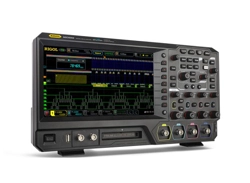Loading ...
Loading ...
Loading ...

Chapter 6 Operations and Measurements RIGOL
MSO5000 User Guide 6-37
parameters.
2
. Source Selection
For different measurement categories, the selection methods for measurement
sources are different.
⚫ Horizontal and vertical parameter measurement
Press Measure → Add → Source A, rotate the multifunction knob to
select the desired channel for measurement and press down the knob to
select it. You can also press Source A continuously or enable the touch
screen to select the current measurement source. The available channels
include CH1-CH4, Math1-Math4, and D0-D15.
⚫ Other (Delay and Phase) parameter measurement
Press Measure → Add → Source A (Source B) to set the two source
channels for the current measurement category. The available channels
include CH1-CH4, Math1-Math4, and D0-D15.
3
. Indicator
Press Indicator to enable or disable the indicator. You can also press Measure
→ Remove → Indicator to enable or disable the indicator. For details, refer to
descriptions in "Measure Mode".
4
. Measurement Settings
Press Measure → Setting to enter the sub-menu of measurement.
⚫ Press Mode to select the measurement mode to "Normal" or
"Precision".
➢ Normal: executes measurement of up to 1 Mpts.
➢ Precision: executes measurement of up to 200 Mpts, improving the
resolution of measurement results. In this mode, the refresh rate of the
waveforms may be reduced.
Tip
⚫ When you rotate the multifunction knob
to switch from the
measurement parameter area to the measurement category area, you
need to press down the knob
to select the desired measurement
category.
⚫ In the measurement category area, rotate the multifunction knob
to
select "Analyze". The following figure is displayed. Select "Counter",
"DVM", "Bode", or "Power" (available when the power analysis option is
installed) to enter the corresponding function setting menu. For
descriptionsn about these functions, refer to relevant chapters.
Loading ...
Loading ...
Loading ...
